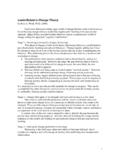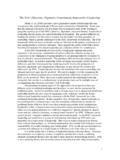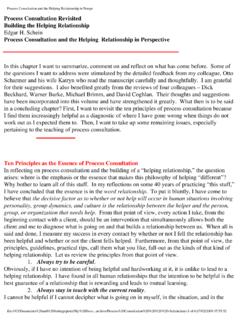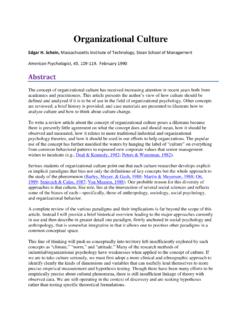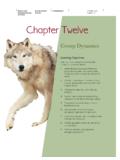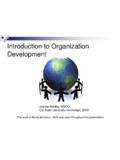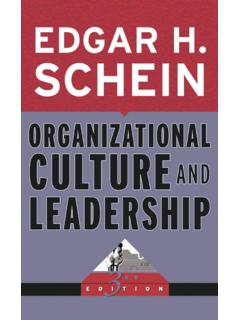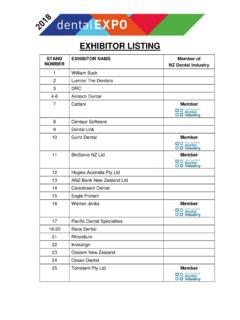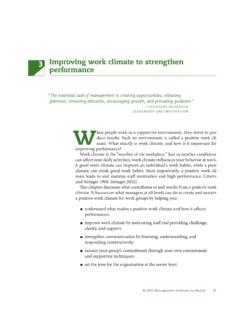Transcription of Organizational Change through Influencing …
1 Ross A. Wirth, (2004) 1 Organizational Change through Influencing Individual Change A behavior centric approach to Change Organizational Change can be described as numerous individuals undergoing a similar Change process at the same time. Each individual will be making choices relative to her personal situation and the culture that binds the group together. While there may be large sub-groups with similar beliefs and values there will also be some individuals that are outside the norm of any particular sub-group. And each sub-group will be sufficiently different from the others as to require special consideration for the Change effort. Similarly, there will be individuals at all stages of readiness to Change , each requiring a different effort for motivating them to the next stage of Change . Therefore, the Organizational Change effort needs to be approached as a process of identifying the individual sub-groups with different decision-making processes and readiness to Change .
2 Each identifiable sub-group will require a Change process tailored to the needs of the individuals within the group. Common throughout this Change effort is the continuing focus on behavior, what drives it and what factors can be leveraged to cause a Change from the existing behavior to another that is desired by the intervener. 1 Internal to the individual Search for understanding of decision-making process that determines behavior Employ the means-end theory (Appendix A) to identify the cognitive processes employed in exhibiting behavior relative to individually held values and beliefs and the expected consequences for choosing a particular behavior among the choices available. 2 External to the individual TTM/SOC study to search for leverage points for possibly Influencing behavior Employ the Transtheoretical Model (TTM, aka SOC Stages of Change ) of Change motivation and the Lewin/Schein Change theory (Appendix B) to identify readiness and motivation for a Change in behavior.
3 3 External interventions acting on decision-making processes Hypothesis testing of ability to influence Change through purposeful interventions This is action research that not only tests hypotheses based on earlier learning, but continually validates earlier findings. In this cycle, diagnosis and intervention are not separate processes, but are closely intertwined with learning as an iterative process. Any initial diagnosis is only a starting point to identify possible interventions. These later interventions provide the arena for the real learning since they provide a basis for testing Ross A. Wirth, (2004) 2 the dynamic relationships that are likely to drive the exhibited behavior. Schein (1995) called this process diagnostic intervention. This also recognizes the potential effect the researcher has just by initiating a diagnostic interview.
4 The interview process itself will Change the system and the nature of that Change will provide some of the most important data about how the system works. will respondents be paranoid and mistrusting, open and helpful, supportive of each other or hostile in their comments about each other, cooperative or aloof, and so on. (Schein, 1995, p. 32) This response also provides some insight into how the individual may respond to later interventions, which is important to know when planning the later interventions. The flow of a Change or managed learning process then is one of continuous diagnosis as one is continuously intervening (p. 36). In addition to focusing on behaviors, the institutional structure can be examined and altered to eliminate the barriers that are limiting Change or to encourage the enablers for Change to occur.
5 Stages of Change (Transtheoretical Model) The Change model presented here is the Transtheoretical Model (TTM) coupled with key components of Lewin s Change Theory (see Appendix B). This approach to Organizational Change focuses attention on the individual with the assumption that Organizational Change is the collective Change of many individuals along the same path. Because many are not familiar with these theories of Organizational Change , the Change model will be described in some detail, including implications for the research processes and the implementation design. This model of Change was developed by Prochaska and DiClemente through the comparative analysis of 18 major psychotherapy and behavioral Change theories, hence, the name transtheoretical (Brown, 1999). From this analysis came the identification of ten Change processes that were employed with different emphasis by each major theory and applied with different weighting of experiential and environmental interventions.
6 They also identified five stages through which individuals progress in the Change process. As will be seen, there is a close relationship between these stages and those identified by Lewin s theory of how Change occurs in individuals (see Appendix B). Ross A. Wirth, (2004) 3 Stages of Change These are simple definitions with some information on how the stage might be identified through the behavior exhibited while in that stage of Change . Precontemplation You are in a state of benign ignorance where you think what you don t know won t hurt you (Booth-Butterfield, 1996). The situation is totally outside the individual s frame of awareness or outside their perceived need. Therefore, there is no problem because there is no awareness of the situation as it might pertain to them. Obviously, there is no intention to Change at this stage and defenses may be raised if pushed to Change .
7 Contemplation Some level of awareness of the problem has been attained and the individual is starting to search for more information. While the search may not be very active or focused, there is some willingness to learn more. There is some knowledge of the benefits, but a large degree of fear of the unknown and the amount of work that may be needed. These feelings lead to procrastination. If forced to Change , defenses remain in place leading to compliance that is not lasting. The individual may welcome assistance in clarifying cost/benefit trade-offs and suggestions on how to Change . Preparation A decision has been made for future action, but the individual is not yet prepared to actually take the action now. Additional thought is needed on the individual steps that need to be taken prior to the new behavior being attempted.
8 Seeing peers in the precontemplation and contemplation stages (80% of others in many research samples) can cause discouragement and questioning of their decision to take action. Culture plays a further function in reinforcing the role implicit assumptions have in perpetuating the status quo. Action Just do it. The new behavior is tried and may be continued for awhile. However, old habits and tendencies toward the old behavior are still in place and a relapse to the old behavior is quite likely. A key part of the TTM model of Change is recognition that Change does not happen once, but requires recurring attempts. Each time a relapse to old behavior occurs there is another learning occasion for identifying the environmental cues to old behavioral patterns. In these cases additional preparation is needed.
9 Maintenance What had been the old behavioral habit has been replaced by the new behavior. Planning and thinking about the new behavior is no longer necessary as the behavior becomes more automatic. The benefits of the Change are being realized and confidence is building on the ability to continue with the Change in behavior. However, in times of stress or unusual environmental conditions a reversion to the old behavior is still likely. This is because only the normal or routine environmental cues that triggered the old behavior have been altered or the past reaction replaced with new behavior. However, not all triggering cues that may be possible will have been altered, creating the possibility for a shift to an earlier stage in an abnormal situation not yet addressed in the Change process to the new behavior.
10 Again, reversion to old habits is not a failure of the Change process, but the identification of another behavioral cue that needs to be addressed. The goal of maintenance is not necessarily action but relapse prevention. Ross A. Wirth, (2004) 4 Where should the Change process be started? Many people might assume that the way to bring about Change is to advocate their position vigorously while showing others why or how their assumptions are flawed. This example of linear thinking encourages Change agents to respond to resistance with greater and greater force. It is counterintuitive to people operating from these assumptions that schismogenetic processes limit the effectiveness of their advocacy. Indeed, the greater the force they use to advocate a shift in values, the more they mobilize forces determined to retain existing values.
